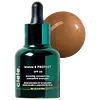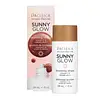ciele. Bronze & Protect SPF 50 Bronzing Concentrate SPF 50+ Versus Pacifica Sunny Glow Bronzing Drops
What's inside
What's inside
 Key Ingredients
Key Ingredients

 Benefits
Benefits

 Concerns
Concerns

 Ingredients Side-by-side
Ingredients Side-by-side

Zinc Oxide 12%
Cosmetic ColorantWater
Skin ConditioningC12-15 Alkyl Benzoate
AntimicrobialButyloctyl Salicylate
Skin ConditioningLauryl PEG-8 Dimethicone
Isododecane
EmollientPropanediol
SolventIron Oxides
CI 77491
Cosmetic ColorantSynthetic Fluorphlogopite
Dimethicone
EmollientNiacinamide
SmoothingPolymethylsilsesquioxane
Isohexadecane
EmollientTrilaureth-4 Phosphate
EmulsifyingDimethiconol
EmollientMica
Cosmetic ColorantCaprylyl Methicone
Skin ConditioningOctyldodecyl Neopentanoate
EmollientLauryl PEG-10 Tris(Trimethylsiloxy)Silylethyl Dimethicone
EmulsifyingCI 77492
Cosmetic ColorantSodium Chloride
MaskingPhenoxyethanol
PreservativeBisabolol
MaskingDisteardimonium Hectorite
StabilisingCI 77499
Cosmetic ColorantCaprylyl Glycol
EmollientAllantoin
Skin ConditioningTitanium Dioxide
Cosmetic ColorantEthylhexylglycerin
Skin ConditioningHexylene Glycol
EmulsifyingPropylene Carbonate
SolventPolyglyceryl-4 Diisostearate/Polyhydroxystearate/Sebacate
EmulsifyingPEG-10
HumectantTetrasodium Glutamate Diacetate
Hydrogenated Lecithin
EmulsifyingTin Oxide
AbrasiveSodium Hydroxide
BufferingZinc Oxide 12%, Water, C12-15 Alkyl Benzoate, Butyloctyl Salicylate, Lauryl PEG-8 Dimethicone, Isododecane, Propanediol, Iron Oxides, CI 77491, Synthetic Fluorphlogopite, Dimethicone, Niacinamide, Polymethylsilsesquioxane, Isohexadecane, Trilaureth-4 Phosphate, Dimethiconol, Mica, Caprylyl Methicone, Octyldodecyl Neopentanoate, Lauryl PEG-10 Tris(Trimethylsiloxy)Silylethyl Dimethicone, CI 77492, Sodium Chloride, Phenoxyethanol, Bisabolol, Disteardimonium Hectorite, CI 77499, Caprylyl Glycol, Allantoin, Titanium Dioxide, Ethylhexylglycerin, Hexylene Glycol, Propylene Carbonate, Polyglyceryl-4 Diisostearate/Polyhydroxystearate/Sebacate, PEG-10, Tetrasodium Glutamate Diacetate, Hydrogenated Lecithin, Tin Oxide, Sodium Hydroxide
Water
Skin ConditioningHydrogenated Polyisobutene
EmollientGlycerin
HumectantGlyceryl Oleate Citrate
EmulsifyingMica
Cosmetic ColorantHydroxyethyl Acrylate/Sodium Acryloyldimethyl Taurate Copolymer
Emulsion StabilisingCoco-Caprylate/Caprate
EmollientCaprylic/Capric Triglyceride
MaskingSilica
AbrasiveSodium Benzoate
MaskingSorbitan Isostearate
EmulsifyingGalactoarabinan
Sodium Ascorbyl Phosphate
AntioxidantTerminalia Ferdinandiana Fruit Extract
AntioxidantGlycolic Acid
BufferingTocopherol
AntioxidantPhenoxyethanol
PreservativeEthylhexylglycerin
Skin ConditioningLimonene
PerfumingBenzyl Alcohol
PerfumingParfum
MaskingIron Oxides
Water, Hydrogenated Polyisobutene, Glycerin, Glyceryl Oleate Citrate, Mica, Hydroxyethyl Acrylate/Sodium Acryloyldimethyl Taurate Copolymer, Coco-Caprylate/Caprate, Caprylic/Capric Triglyceride, Silica, Sodium Benzoate, Sorbitan Isostearate, Galactoarabinan, Sodium Ascorbyl Phosphate, Terminalia Ferdinandiana Fruit Extract, Glycolic Acid, Tocopherol, Phenoxyethanol, Ethylhexylglycerin, Limonene, Benzyl Alcohol, Parfum, Iron Oxides
Ingredients Explained
These ingredients are found in both products.
Ingredients higher up in an ingredient list are typically present in a larger amount.
Ethylhexylglycerin (we can't pronounce this either) is commonly used as a preservative and skin softener. It is derived from glyceryl.
You might see Ethylhexylglycerin often paired with other preservatives such as phenoxyethanol. Ethylhexylglycerin has been found to increase the effectiveness of these other preservatives.
Mica is a naturally occurring mineral used to add shimmer and color in cosmetics. It can also help improve the texture of a product or give it an opaque, white/silver color.
Serecite is the name for very fine but ragged grains of mica.
This ingredient is often coated with metal oxides like titanium dioxide. Trace amounts of heavy metals may be found in mica, but these metals are not harmful in our personal products.
Mica has been used since prehistoric times throughout the world. Ancient Egyptian, Indian, Greek, Roman, Aztec, and Chinese civilizations have used mica.
Learn more about MicaPhenoxyethanol is a preservative that has germicide, antimicrobial, and aromatic properties. Studies show that phenoxyethanol can prevent microbial growth. By itself, it has a scent that is similar to that of a rose.
It's often used in formulations along with Caprylyl Glycol to preserve the shelf life of products.
Water. It's the most common cosmetic ingredient of all. You'll usually see it at the top of ingredient lists, meaning that it makes up the largest part of the product.
So why is it so popular? Water most often acts as a solvent - this means that it helps dissolve other ingredients into the formulation.
You'll also recognize water as that liquid we all need to stay alive. If you see this, drink a glass of water. Stay hydrated!
Learn more about WaterThis ingredient is a combination of red, black, and yellow iron oxide pigments. This combination of colors is usually found in foundation, because it results in a "skin" color.